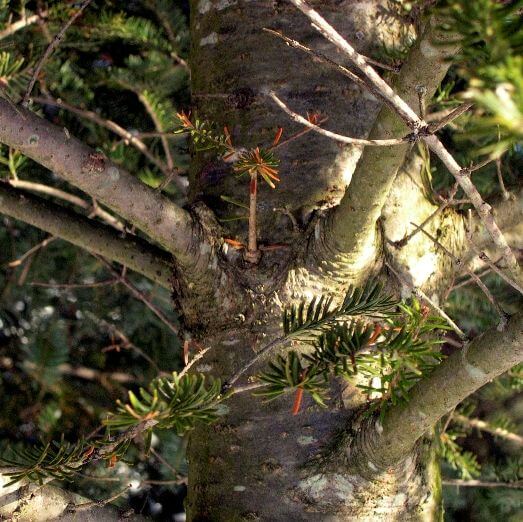Botanical information
| Latin Name: | Abies balsamea |
| English Name: | Balsam Fir |
| French Name: | Balsam fir |
| Other Name: | Iroquoian or Huron: Annedda |
| Family: | Pinaceae |
| Origin: | Quebec, Canada |
History and Origin
Balsam Fir is one of the typical trees to our Boreal
AROMATHERAPY DATA SHEET
| Distilled Part: | Bark |
| Extraction: | Steam distillation |
| Main Components: | α-pinene, ß-pinene, Δ-3-carene, ß-phellandrene, limonene, myrcene. |
| Oil Characteristics: | Transparent and clear fluid |
| Properties: |
Antiseptic++, anti-parasitic, antispasmodic+, anti-arthrosic+, stimulant, analgesic. |
| Indications: |
Rhinitis+, bronchitis, asthma, sinusitis++ (staphylococus aureus), colds+, aerophagia+, ascaridiosis, arthrosis, and arthritis |
USES
Culinary
In a number of delicatessen, we can find fir jam or infused salad dressing or even herbal tea of the fresh shoots.
Environment
Balsam fir is used for its fresh and fruity aroma in many soaps and multipurpose detergents.
Perfumery
Typical coniferous smell, yet mildly sweet and fruity. Head and heart notes. The smell of the essential oil made from the bark is sweeter and milder than the one obtained from the needles.
Synergy
The synergy of Sweet Orange and Balsam Fir creates energizing and uplifting atmosphere during winter time.
Therapeutic uses
- Diffusion: respiratory disorders
- Thoracic rubs: lung problems
- Local rubs: muscular
DOCUMENTATION AND REFERENCES
- FRANCHOMME, Pierre, Doctor PÉNOËL, Daniel, Aromatherapy exactly , Roger Jollois Editions.
- MARIE VICTORIN, The Laurentian Flora , Gaëtan Morin Editor.
- LAWLESS, Julia, The Illustrated Encyclopedia of Essential Oils , Element.
- MOERMAN, Daniel E., Native American Ethnobotany , Timber Press.
- MATHIEU, Jacques, The Annedda, The Tree of Life , Septentrion Editions


 PRODUCT DESCRIPTION
PRODUCT DESCRIPTION









